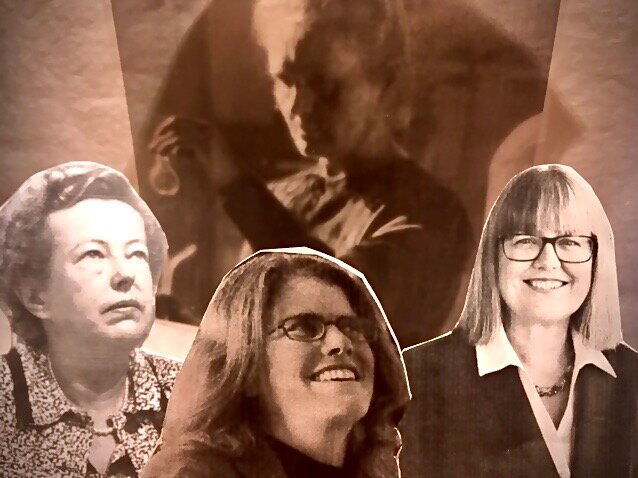Sung and Unsung Women of the Nobel Prize in Physics
The four women Nobel Prize in Physics winners (so far): from left, Maria Goeppert Mayer (1963), Andrea Ghez (2020) and Donna Strickland (2018). Marie Curie (1903) is in the background.
When I was finishing a first draft of Half Life, a novel whose main character is a middle-aged physics teacher, the 2018 Nobel Prize for Physics was awarded to Canadian Donna Strickland, the third time in its nearly 120-year history a woman received the prize.
The prize worked its way into my novel in the form of a promise my main character makes to herself.
This fall, the 2020 Nobel Prize for Physics was awarded to the American astrophysicist Andrea Ghez, for her work identifying a super massive black hole at the centre of the Milky Way. Now four women have that prize. Which is cause for celebration. Or dismay.
There’s only a two-year gap between these two most recent female recipients of the Nobel Prize in Physics. But when Strickland won for the discovery that led to short-pulse high-intensity lasers, she ended a 55-year drought for women that followed the 1963 prize to Maria Goeppert Mayer.
And Goeppert-Mayer, whose magic number theory changed our understanding of nuclear structure, had the distinction bestowed on her 60 years after Marie Curie became the first woman to win a Nobel Prize in Physics in 1903.
After the 2020 prize was announced, Strickland told a “Why the Nobel Prize Matters” webinar that the dam is breaking for women.
I hope this is true. I also hope the breaking dam unearths the stories of the many women physicists whose genius was borrowed, buried, unacknowledged and unprized.
I’d never heard of Goeppert Mayer until Strickland’s breakthrough for women and Canadian physicists. But discovering her led me to other female physicists, including Lise Meitner and Chien-Shiung Wu, who didn’t win Nobel Prizes, and arguably should have.
They began showing up in my novel too, as my main character Elin, grappling with thwarted scientific ambition, becomes preoccupied with scientists at the beginnings of quantum mechanics and nuclear physics, including its forgotten women. Such a systemic forgetting of these physicists converges with the murkier secrets of Elin’s family.
In more recent history, there was Jocelyn Bell Burnell. As a post-graduate student at Cambridge, she was the very first person to observe a pulsar, those dense compact stars that create pulses of electromagnetic radiation at highly precise intervals. It’s considered among the greatest astro-physics discoveries of all time. In media interviews that followed the announcement of her findings, she was asked for her hair color and whether she had a boyfriend. When the Nobel Prize in Physics was awarded for this discovery in 1974, it was given to her supervisor. She wasn’t named.
In 2018, Bell Burnell was awarded the $3 million Breakthrough Prize, and donated it to U.K.'s Institute of Physics, for scholarships that will open up the study of physics for under-represented groups.
Yet encouraging more women to do doctoral work in physics might not be enough, without more women making the nominations for the big prizes as well.
When the Nobel Prize for Physics was announced this fall, Ghez told The Washington Post, “… “I take very seriously the responsibility of being the fourth woman to win the Nobel Prize. I hope I can inspire other young women into the field. It’s a field that has so many pleasures, and if you’re passionate about the science, there’s so much to be done.”
Strickland and Ghez, and the small amount of time between their prize wins, is good news for physics. But when it comes to opening up the field and its rich prizes, there is as much to be done as there is to be remembered.
